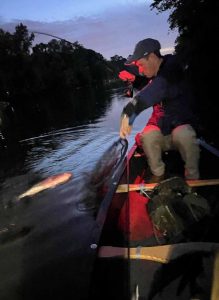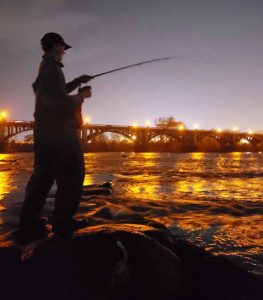
As the first hints of spring start to emerge, a remarkable event begins to take place in the rivers surrounding Columbia, SC. It’s the annual striper run. These striper have swam for nearly a hundred miles from Lake Marion and Lake Moultrie to spawn in the swift currents of the Congaree, Broad, and Saluda Rivers in Columbia.
I have learned a lot over my seven years of fishing the striper migration but the one thing that took the longest and is most important is knowing when the striper arrive. The general rule of thumb is to start fishing when the dogwoods bloom in March, but large spawning females often arrive earlier. Catching spawning female striper requires repetitive casting, working known hot spots. Another lesson that we learned this year is that the striper bite gets more aggressive after dark.
My first attempt this season was March 16 when I was passing through Columbia after work. I called Josh Brown, who is a student at the University of South Carolina, and we met at the Gervais St. Bridge to hike to a spot that we know as “The Not-So-Secret Spot.”
Josh and I strapped on our waders, rigged baits, and were wading out into the Congaree River at 6 p.m. We stepped onto some rocks after wading through rapids and started casting into the current. Other fishermen showed up and fished from land, but nobody caught anything until I tied a bucktail dropper behind my topwater pencil popper. I hurled the double rig out into the current and felt it get slammed on the first cast. Landing a single striper is a great day and I fought the fish carefully until it was splashing in the rapids at my feet. I scooped it up in the net and held a heavy female striper that was full of eggs. I released her to continue her journey and picked up my rod to keep casting.
Josh was shivering in his leaking waders and had gone back to land. We tried talking occasionally but couldn’t hear each other over the noise of the rapids. It was getting dark now and we could see the lights of the Gervais Bridge and the Columbia city skyline lighting up.
I had two rods, each with a different lure so I could quickly change lures without tying a knot. I picked up a rod with a soft plastic paddle-tail and started casting. I quickly caught a striper on it, which I also released. There were many rocks where we were fishing, so it was no surprise when I hooked the bottom and had to break my line. I tied on another paddle-tail that imitates a shad and started casting. As I was retrieving the lure, I felt a thump on my line. I set the hook and immediately felt the fish thrashing and my drag getting pulled out. I could hear the distant splashing in the dark and finally landed a striper in the net. I hastily removed the hook, made another cast into the same place, and immediately got another bite. I turned around and yelled, “Josh come out here!” Josh waded out to through the rapids while I fought the striper and arrived in time to net the fish. I released my striper and Josh climbed up onto the rock to start casting.
Josh felt a thump and set the hook on a striper which took off in the current. He countered the fish, leaning with the rod and soon, the fish was splashing at the base of our rock. I scooped up his striper in the net and Josh said it was his first. It was 9 p.m. and we decided to quit for the night. Josh returned the next day to catch another, but it would be a month before I caught my next striper.
Dawson Jordan and I took my canoe to the Saluda River on April 22 and started fishing at 5:30 a.m. I caught our only striper of the day at 6 a.m., and we quit fishing at 8 a.m. because the primary purpose of this trip was to participate in a lure sale. We drove to the lure sale and met a handful of the local striper crew there. K4 Lure Building was having a sale of homemade spooks, pencil lures, and glide baits, made of wood. I can buy spooks and pencils at any bait store, but I wanted to stock up on the handmade glide baits. What I enjoyed more than buying the perfect glide baits was talking with the other fishermen and hearing their stories and strategies.
I would return to the river 3 days later and make my stand at the “Not So Secret Spot” again. That night I reached the river at 9:30 p.m. I clicked my headlight on and waded out into the waters of the Congaree River to embark on my nocturnal fishing expedition. As I walked, I saw a striper dart through my path as it swam upstream. I thought it might be a positive sign, and tied a new, handmade wooden glide bait to my 11′ surf rod.
I reached the rock and had my first bite within 10 minutes and fought the striper. Each fish strikes like a giant and it is not until later in the fight before I really know what I am dealing with. I stepped off the rock into the water and waited for the fish to pause before grabbing its mouth. I removed the hook and held it in the water for a few minutes before letting it swim out of my grip. I climbed back up on the rocks and started casting again.
I changed my headlamp from white to red light so I can maintain my night vision and see more distant objects. I cast the glide bait again and worked it all the way back to the base of the rapids beneath my rock. The striper often rest in the still waters behind the rocks so it is important to work the lure all the way back to the rod tip. On one retrieval, my lure got smashed right in front of me and the splash startled me. I fumbled to get the rod in position to reel and landed the second striper. At this point, I knew that I was in the right place to catch a lot of striper, and if I was lucky, to connect with a giant.
I continued to cast until midnight and caught three more striper for a total of five fish for the evening, but there was one that was able to shake the hook before coming into sight. Because I never saw it, my mind has convinced me that it could have been the 40” striper that I have been looking for. Regardless of what it could have been, I waded back to land happy with the results of the night. All of the fish I caught were solid striper, and I was extremely happy with the performance of the new wooden lures.
The search for striper continues as we switch our focus to the Saluda River in late Spring and Summer. More attempts have been made since this night, with more injuries than fish, but knowing what is out there and the hope of getting the strike keeps us going back for more.



